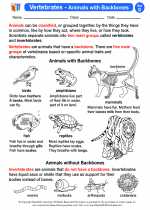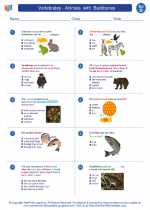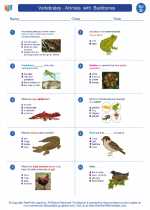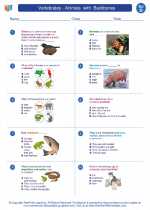Vertebrates - Animals with Backbones -> cartilage
What is Cartilage?
Cartilage is a type of connective tissue found in the human body. It is a firm, flexible tissue that is not as hard as bone but is stiffer and less flexible than muscle.
Types of Cartilage
There are three main types of cartilage in the human body:
- Hyaline cartilage: found at the ends of bones, in the nose, and in the trachea and larynx.
- Elastic cartilage: found in the external ear and parts of the larynx.
- Fibrocartilage: found in the intervertebral discs and in some joints.
Functions of Cartilage
Cartilage serves several important functions in the body:
- It provides a smooth surface for joint movement.
- It acts as a shock absorber in the joints.
- It provides structure and support to the body, such as in the nose and ears.
Cartilage Growth and Repair
Unlike other types of connective tissue, cartilage does not have its own blood supply. As a result, it has a limited capacity for self-repair. Cartilage growth and repair are slower processes compared to other tissues in the body.
Study Guide
Here are some key points to remember about cartilage:
- What are the three main types of cartilage in the human body?
- What are the functions of cartilage in the body?
- How does cartilage differ from bone and muscle in terms of hardness and flexibility?
- Why does cartilage have a limited capacity for self-repair?
◂Science Worksheets and Study Guides Fourth Grade. Vertebrates - Animals with Backbones
Study Guide Vertebrates - Animals with Backbones
Vertebrates - Animals with Backbones  Activity Lesson
Activity Lesson Vertebrates - Animals with Backbones
Vertebrates - Animals with Backbones  Worksheet/Answer key
Worksheet/Answer key Vertebrates - Animals with Backbones
Vertebrates - Animals with Backbones  Worksheet/Answer key
Worksheet/Answer key Vertebrates - Animals with Backbones
Vertebrates - Animals with Backbones  Worksheet/Answer key
Worksheet/Answer key Vertebrates - Animals with Backbones
Vertebrates - Animals with Backbones  Worksheet/Answer key
Worksheet/Answer key Vertebrates
Vertebrates  Vocabulary/Answer key
Vocabulary/Answer key Vertebrates - Animals with Backbones
Vertebrates - Animals with Backbones  Vocabulary/Answer key
Vocabulary/Answer key Vertebrates - Animals with Backbones
Vertebrates - Animals with Backbones  Vocabulary/Answer key
Vocabulary/Answer key Vertebrates - Animals with Backbones
Vertebrates - Animals with Backbones  Vocabulary/Answer key
Vocabulary/Answer key Vertebrates - Animals with Backbones
Vertebrates - Animals with Backbones 

 Activity Lesson
Activity Lesson
 Worksheet/Answer key
Worksheet/Answer key
 Worksheet/Answer key
Worksheet/Answer key
 Worksheet/Answer key
Worksheet/Answer key
 Worksheet/Answer key
Worksheet/Answer key
 Vocabulary/Answer key
Vocabulary/Answer key
 Vocabulary/Answer key
Vocabulary/Answer key
 Vocabulary/Answer key
Vocabulary/Answer key
 Vocabulary/Answer key
Vocabulary/Answer key

The resources above cover the following skills:
Life Science: The students will use scientific skills and processes to explain the dynamic nature of living things, their interactions, and the results from the interactions that occur over time.
Diversity of Life: Explain how animals and plants can be grouped according to observable features.
Classify a variety of animals and plants according to their observable features and provide reasons for placing them into different groups.